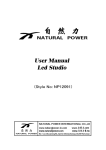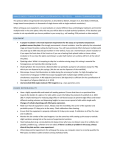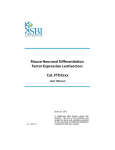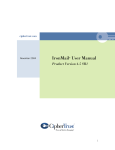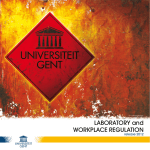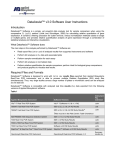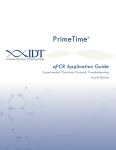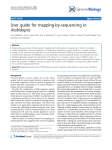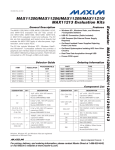Download "user manual"
Transcript
manual last update on July 8, 2008 1. Introduction The geNorm VBA applet for Microsoft Excel determines the most stable reference genes from a set of tested genes in a given cDNA sample panel, and calculates a gene expression normalization factor for each tissue sample based on the geometric mean of a user-defined number of reference genes. geNorm calculates the gene expression stability measure M for a reference gene as the average pairwise variation V for that gene with all other tested reference genes. Stepwise exclusion of the gene with the highest M value allows ranking of the tested genes according to their expression stability. The underlying principles and calculations are described in Vandesompele et al., Genome Biology, 2002, Accurate normalization of real-time quantitative RT-PCR data by geometric averaging of multiple internal reference genes. The full article can be read at http://genomebiology.com/2002/3/7/research/0034/ Please check the geNorm website at http://medgen.ugent.be/genorm/ for updates of the applet and user manual. The current geNorm version is 3.5. An accompanying discussion group can be found at http://groups.yahoo.com/group/genorm Ghent University recommends the use of a geNormTM kit alongside the geNorm software. geNormTM kits for a wide variety of species can be purchased from PrimerDesign Ltd. Each kit contains a panel of high quality real-time PCR primers for candidate reference genes. Kits can be shipped anywhere in the World. More details can be found at http://www.primerdesign.co.uk/geNorm.asp PrimerDesign is an innovative biotechnology company founded within Southampton University's School of Medicine and focused on developing improved solutions for gene quantification by real-time PCR. 1/16 2. Installation (Windows version) Unzip the downloaded geNorm_3.5.zip file. After unzipping, a geNorm directory is created, which contains the geNorm.xls applet, and an InputData directory and OutputData directory. The InputData directory contains a demo data file (fibroblast.xls described in Vandesompele et al., 2002, Genome Biology), and the OutputData directory contains the user manual as a PDF file). geNorm requires Microsoft Excel version 2000, XP or 2003 on a Windows platform. geNorm does not work in Excel 2007 due to a change in the VBA code base. 2/16 3. Menu bar Load input data loads Excel data file (see Requirements for data format) Manual data input provides possibility to type the data manually; indicate the number of samples and reference genes to be analyzed Criteria settings adjusts the expression stability threshold below which genes are included in the calculation of a normalization factor; genes (expression values) that are used for normalization are displayed in black, while genes in grey (inactive) are not used to calculate the normalization factors Delete row remove sample Insert row insert sample Delete column remove gene Insert column insert gene Show matrix displays the pairwise variation V values for each gene with all other genes; click Return to leave the matrix view Print/Save report Save input data Automated analysis automatic ranking of reference genes according to their expression stability (chart 1) and determination of optimal number of reference genes (chart 2) Zoom user-adjustable zoom level, e.g. allows to view all genes and/or samples by highlighting the cells of interest, and selecting ‘fit to selection’ Clear screen About geNorm brief information on contact address, method, input file, menu icons, and link to the most recent manual on the web Exit geNorm quit the application 3/16 4. How to determine the most stable reference genes? Manual method 1. close all running instances of Microsoft Excel 2. start up the geNorm applet (in Excel: Open File, or double click on the geNorm.xls file) 3. enable macro’s when prompted 4. load the expression data matrix (raw data; this means not yet normalized expression levels – see requirements for data file) 5. press the Calculate button 6. The M values of the least and most stable genes are now highlighted in red and green respectively. 7. To eliminate the gene with the highest M value (this is the least stable gene), click on the gene name (top row), and subsequently click the Delete column button. Repeating this process leads to stepwise elimination of the least stable reference genes, until you end up with the two best reference genes (which can’t be further ranked). Automated analysis 1. close all running instances of Microsoft Excel 2. start up the geNorm applet (in Excel: Open File, or double click on the geNorm.xls file) 3. enable macro’s when prompted 4. load the expression data matrix (raw data; this means not yet normalized expression levels – see requirements for data file) 5. press the Calculate button 6. press the Automated analysis icon in the menu bar 7. A first chart is generated (Figure 2 equivalent from the Genome Biology paper), indicating the average expression stability value of remaining reference genes at each step during stepwise exclusion of the least stable reference gene. Starting from the least stable gene at the left, the genes are ranked according to increasing expression stability, ending with the two most stable genes at the right (which can’t be further ranked). Example (fibroblast data): first step: an M value for all 10 genes is calculated GAPD 0.687 ACTB 0.864 B2M 1.076 HMBS 1.128 HPRT1 0.651 RPL13A SDHA 0.873 0.762 TBP 0.928 UBC 0.700 YHWAZ 0.651 with an average M value for the 10 genes of 0.832 (see Figure below) second step: the gene with the highest M value is excluded (HMBS), and new M values are calculated for the remaining 9 genes GAPD 0.669 ACTB 0.795 B2M 1.050 HPRT1 0.619 RPL13A SDHA 0.851 0.735 TBP 0.853 UBC 0.644 YHWAZ 0.607 with an average M value for the 9 remaining genes of 0.758 (see Figure below) etc. (this process is repeated until only 2 genes remain) 4/16 8. A second click on the chart icon generates a figure equivalent to Genome Biology Figure 3a, indicating the pairwise variation V between two sequential normalization factors containing an increasing number of genes. A large variation means that the added gene has a significant effect and should preferably be included for calculation of a reliable normalization factor. Based on the Genome Biology data, we proposed 0.15 as a cut-off value, below which the inclusion of an additional reference gene is not required. For example, if the V3/4 value is 0.22, then the normalization factor should preferably contain at least the 4 best reference genes. Subsequently, if the V4/5 value is 0.14, then there’s no real need to include a 5th gene in the normalization factor. An optimal number of reference genes for normalization in this example would therefore be 4. Note: Please bear in mind that the proposed 0.15 value must not be taken as a too strict cut-off. The second graph is only intended to be guidance for determination of the optimal number of reference genes. Sometimes, the observed trend (of changing V values when using additional genes) can be equally informative. Anyway, ‘just’ using the 3 best reference genes (and ignoring this second graph) is in most cases a valid normalization strategy, and results in much more accurate and reliable normalization compared to the use of only one single reference gene. 5/16 5. Normalization flow chart In the following example, 5 reference genes (HK) and one gene of interest (GOI) are quantified in 4 different samples by means of real-time RT-PCR. It’s highly recommended that the genes are quantified on the same batch of cDNA, to minimize experimental variation (in large part due to cDNA synthesis). We routinely make cDNA from 2 µg of total RNA, which is sufficient to quantify 50 different genes (including a number of reference genes) in duplicated reaction tubes (see Vandesompele et al., 2002, Analytical Biochemistry). Furthermore, we strongly advice to test the same gene on the different samples in the same PCR run (to exclude further variation; see also section 7). The Ct values are transformed to quantities (either by using standard curves or the comparative Ct method). Here, the highest relative quantities for each gene are set to 1. These raw -not yet normalized- reference gene quantities are the required data input for geNorm. In this example, geNorm analysis would indicate that HK1, HK2 and HK3 are the most stable genes. Hence, after calculation of a normalization factor (either by geNorm, or by manually calculating the geometric mean of these 3 reference genes), the normalized GOI expression levels can be calculated by dividing the raw GOI quantities for each sample by the appropriate normalization factor. 6/16 6. Calculation standard deviation on normalized expression levels To calculate the standard deviation (SD) on the normalized gene of interest (GOInorm) expression levels, the error propagation rules for independent variables have to be applied. standard deviation on a relative expression value the delta-Ct formula for transforming Ct values to relative quantities with the highest expression level set to 1: Q = E deltaCt Q = E (minCt - sampleCt) (1) (2) Q = sample quantity relative to sample with highest expression E = amplification efficiency (2 = 100%) minCt = lowest Ct value = Ct value of sample with highest expression The SD for this relative quantity Q is (see addendum for derivation of formula): SD Q = E deltaCt ⋅ ln E ⋅ SD sampleCt (3) lnE = natural logarithm of the amplification efficiency SD sampleCt = standard deviation Ct values of the sample replicates standard deviation for normalized expression levels Suppose n reference genes (REF) and one gene of interest (GOI) - each with their own SD values (calculated as outlined above) – are measured, and the geometric mean of the n housekeepers is calculated as a reliable normalization factor (NFn): gene of interest housekeeper 1 housekeeper n GOI ± (SD GOI) REF1 ± (SD REF1) REFn ± (SD REFn) The Normalization Factor based on n reference genes is: NFn = n REF1 . REF2 . L . REFn (4) (geometric mean) The standard deviation for this Normalization Factor is: 2 2 SD REF1 SD REF2 SD REFn + + L + SD NFn = NFn . n . REF1 n . REF2 n . REFn 7/16 2 (5) The standard deviation for the normalized GOI is: SD GOI norm SD NFn = GOI norm . NFn 2 SD GOI + GOI 2 (6) It might be more interesting to use standard error (SE) values instead of standard deviations (SD), as the latter is the error on a single measured value, and the former is the error on the mean (of repeated measurements). Furthermore, the SE value adds confidence to the calculated mean: the true mean has a 95% chance of lying between the measured mean ± 1.96 times the SE. SE = SD (m = number of measurements, i.e. 3 for triplicates in a PCR) m The error propagation rules are identical when using SD or SE values, just replace the SD values with SE values in formula 5 and 6. Note however that the above described procedure only provides the error for the normalized expression level of a gene of interest for a single sample (mainly reflecting technical and pipetting variation, and variation among the different reference genes used for normalization). If you however average multiple samples (e.g. biological replicates (same cells independently grown or harvested), technical replicates (testing the same sample in different runs), or grouping samples with similar properties (e.g. diseased versus healthy tissue samples), different rules apply! This is a typical ANOVA (analysis of variance) problem, which can in most cases not be solved using standard ANOVA statistics, because the number of replicates/repeated experiments/to be grouped samples is often too small, and because the results of the different PCR runs are most often not easily linked to each other (due to the experimental variation; this is only possible after correcting for reference samples which are tested in both experiments, e.g. the same standards or samples run on both plates). In fact, there are 2 kind of variances: a so-called within variance (this is the variance for the normalized gene expression level of one sample in a single experiment), and a between variance (for biological or technical replicates, or sample groupings based on similar characteristics). The between variance is typically much higher than the within variance! For the final between variance, you don't need the within variance in this kind of small experiments, you just consider your replicates (or multiple samples) as independent measurements, and calculate the standard deviation on these measurements. Just make sure that you can actually compare the different results (which is natural if samples were analysed on the same plate, but which is not trivial when samples are analysed on different plates! See also section 7). 8/16 example: GOI +/- SD (experiment 1, after normalization): 11.0 +/- 1.5 GOI +/- SD (experiment 2, after normalization): 13.0 +/- 1.8 GOI +/- SD (experiment 3, after normalization): 10.0 +/- 1.9 mean GOI +/- SD: 11.33 +/- 1.53 (= SD(11;13;10)) A detailed example illustrating all calculations (normalization and error propagation) is available as Excel file on the geNorm website: http://medgen.ugent.be/~jvdesomp/genorm/example_calculations.xls 7. Requirements 1. We have tested the applet only in Microsoft Excel version 2000, XP and 2003 on a Windows platform. We cannot guarantee that the VBA applet works on other platforms or other Microsoft Excel versions. Please let us know if you successfully use geNorm on another platform/Excel version. geNorm does not work in Excel 2007 due to a change in the VBA code base. 2. Macro’s need to be enabled in Excel. If the message prompt “enable macro’s” is not displayed while opening geNorm, please check that the Security level in Excel is not set at High, but rather at Medium (in Excel 2000/XP/2003: Tools – Macro – Security). 3. Use a point (.) as decimal separator (important for continental Europe where a comma (,) is normally used for this purpose). To change the decimal separator used in Excel, go to Tools > Options > International Tab. Alternatively, you could change the decimal separator symbol in your operating system, please consult the appropriate manual or help file for your system (in Windows: Start button – Settings - Control Panel Regional Settings). 4. The input file should be an Excel data table, with the first column containing the sample names and the first row containing the gene names. The first cell of the first row and column (cell A1) should be empty. The other cells contain the relative gene expression levels. Empty cells are NOT allowed. The input file should be saved in the InputData directory, where also an example data file is located. Raw expression levels are needed for input; these are the quantities (NOT Ct values!) obtained from a real-time RT-PCR run, either trough a standard curve, or via the delta-Ct method (also called comparative Ct method, see FAQ section for more information). A prerequisite is that the raw data are comparable between the samples. This is easily achieved for samples tested in the same plate. If you want to compare quantities between plates, then you need a few controls (either a dilution series of the same standard, or say 3-5 experimental samples, which are run on both plates; using these standards or samples, you can link the data sets of both plates). Please bear in mind that real-time PCR is all about relative quantification (relating the quantity of one sample to another), and that it is therefore better to test different samples in the same run (which you can then 9/16 easily and reliably compare). You want to compare several samples for the same gene, not several genes for the same sample. 10/16 8. Frequently Asked Questions Q1: A1: When I load geNorm, the menu bar is not visible Close all open instances of Microsoft Excel and reload geNorm Q2: A2: What should I do if I have an empty cell? Remove sample OR remove gene which contains an empty value, and recalculate. To remove the sample, click on the empty cell, and then click on the Delete row button. To remove the gene, click on the empty cell, and the click on the Delete column button. Q3: How many samples should I analyze to determine which reference genes are most stable? In principle, any number of samples higher than 2 would be sufficient. However, the more samples you use, the more reliable are the conclusions. We propose to use at least 10 samples. A3: Q4: A4: Do I always have to retest and determine which genes are the most stable, and should be used for normalization? This depends on your experimental setup. Once you have determined which genes and how many are required for accurate and reliable normalization, you can use this information for future experiments, as long as no significant changes in the experimental setup have been introduced. e.g. once you have determined that HPRT1, GAPD and YWHAZ are the most stable reference genes for short term cultured human fibroblasts, you can use these genes for normalization of all future fibroblast samples, as long as you keep the culture conditions, harvesting procedures, etc. identical. Importantly, the real-time PCR data-analysis software qBasePlus (http://www.biogazelle.com) has built in geNorm technology for systematic assessment of expression stability of reference genes in each experiment. Q5: A5: Whom should I contact if I have further questions? Please do not ask questions directly to one of the authors. Instead use the geNorm discussion forum to ask your question, or give feedback. This forum intends to be a venue where geNorm users can interact and help each other. Additionally, information can be posted which genes are most suited for which biological system. The geNorm discussion forum can be found at http://groups.yahoo.com/group/genorm Q6: The geometric mean I calculate is different from the normalization factor geNorm displays! The normalization factors calculated by geNorm are subsequently divided by the geometric mean of all normalization factors. This additional step is only performed to distribute the normalization factors around value 1, but has NO effect on the net result of your gene of interest (due to the relative nature of the expression levels). Both normalization factors are equivalent. A6: 11/16 Q7: A7: When or why would you use the Criteria settings option? Two strategies are available to calculate a normalization factor. In a first strategy, you simply import the raw expression levels of e.g. 10 reference genes, and adjust the expression stability threshold, so that a userdefined number of genes (all with an expression stability value below the threshold) are included in the calculation of a normalization factor. Doing so, you simply exclude a number of genes to take part in the normalization factor. A second strategy is partially explained in section 4. It’s a stepwise exclusion of the least stable reference gene, until you end up with 3 (or more if necessary) stable reference genes. Then you make sure that the stability threshold value is higher than the stability values of the remaining reference genes you intend to use for normalization. Doing so, all remaining genes are used to calculate the normalization factors. We prefer the second strategy, as also outlined in the accompanying article (Vandesompele et al., 2002, Genome Biology). Q8: A9: What is the difference between the delta-delta-Ct and delta-Ct method? The delta-delta-Ct method transforms Ct values into normalized relative expression levels, by relating the Ct value of your target gene in your sample to a calibrator/control sample AND to the Ct value of a reference gene in both samples. Note that in the original publication of the deltadelta-Ct method (Applied Biosystems technical bulletin), there’s no correction for a difference in amplification efficiency between the target and reference gene (only the underlying requirement that the efficiency of target and reference gene should be similar). In the delta-Ct method, you don't use any reference gene; you just relate the Ct value of your gene (either target or reference) to a control/calibrator. This control/calibrator can be any sample: e.g. a real untreated control, or the sample with the highest expression (lowest Ct value). The delta-Ct method generates raw (not-normalized) expression values, which need to be normalized by dividing with a proper normalization factor. Doing 3 times delta-delta-Ct between your gene of interest and 3 reference genes, and then taking the geometric mean of the 3 relative quantifications, is the same as first transforming the Ct values of your 4 genes to quantities using delta-Ct, and dividing the gene of interest by the geometric mean of the reference genes. Although both approaches yield the same result, I favour the delta-Ct method, because a) it's much easier to do in Excel, b) it's very easy to take different amplification efficiencies for the different genes into account (just replace value 2 with the actual efficiency of the gene (e.g. 1.95 for 95%) in the formula of delta-Ct), and c) it allows easy inclusion of multiple reference genes for normalization. Q9: When using replicated tubes in the same run, should I average first the Ct values and then transform to quantities, or vice versa? Transforming the arithmetic mean Ct value to a quantity is equivalent to transforming each Ct value to a quantity, and then calculating the geometric mean of the individual replicate quantities. However, for determination of the error propagation, the first procedure is much more A9: 12/16 straightforward (and therefore is used in the example calculation file on the geNorm web site) Q10: What is the difference between relative and absolute quantification? A10: Both comparative Ct methods (delta-delta or delta) and standard curves (based on serial dilutions of a template of which you do not know the exact copy number) can be considered as relative quantification methods (in which you relate the normalized expression level of one sample to another). For absolute quantification, you definitely need standard curves, based on a template of which your measured the absolute number of molecules. It's still a matter of debate however if you can extrapolate copy numbers from a standard dilution (most often PCR product or plasmid) to the number of molecules in a cDNA sample. Q11: The graph for "Determination of the optimal number of reference genes for normalization" appears empty. A11: This problem generally occurs if your decimal separator settings are not correct (see 7.3 for required settings), or if you used the copy/paste method for loading data into geNorm (in contrast to the preferred way of preparing an input file and importing this file into geNorm, see 7.4). Q12: There is no gene expression stability value for the least stable gene in the “Average expression stability of remaining reference genes” graph. A12: This is caused by not clicking on the Calculation button (top left cell of the expression data matrix). 13/16 9. Manual Version History July 21, 2002 first version August 19, 2002 compliant with geNorm geNorm3.2 successfully tested for the XP version of Microsoft Excel ‘Manual Version History’ section added ‘References’ section added September 6, 2002 ‘Calculation standard deviation after normalization’ section added February 17, 2003 compliant with newest geNorm version 3.2c (bug fix release of 3.2) ‘Save report’ now works ‘Criteria settings’ in Excel XP works ‘Show matrix’ does not display anymore Spearman rank correlation values (relic from the first geNorm versions) besides to the intended pairwise variation V values (which is a much better and robust measure) November 10, 2003 compliant with geNorm version 3.3 automatic ranking of the reference genes according to their expression stability (‘Automated analysis’) determination of the optimal number of reference genes for normalization (‘Automated analysis’) extended FAQ and data requirement section extended and slightly modified error propagation procedure September 6, 2004 updated URLs compliant with geNorm version 3.4 (bug fix release of 3.3) August 14, 2006 FAQ section extended March 13, 2007 Minor bug fix geNorm kit section added qBase article reference added compliant with geNorm version 3.5 July 8, 2008 explicit mentioning that geNorm does not work in Office2007 minor updates reference to qBasePlus software based on Ghent University’s geNorm and qBase technology 14/16 10. References Vandesompele J, De Preter K, Pattyn F, Poppe B, Van Roy N, De Paepe A, Speleman F (2002) Accurate normalization of real-time quantitative RT-PCR data by geometric averaging of multiple internal control genes. Genome Biology, 3, 34.1-34.11. Vandesompele J, De Paepe A, Speleman F (2002) Elimination of primer-dimer artifacts and genomic coamplification using a two-step SYBR green I realtime RT-PCR. Anal Biochem, 303, 95-98. Hellemans J, Mortier G, De Paepe A, Speleman F, Vandesompele J (2007) qBase relative quantification framework and software for management and automated analysis of real-time quantitative PCR data. Genome Biology, 8:R19 http://medgen.ugent.be/qbase A growing list of articles citing the geNorm method (Vandesompele et al., Genome Biology, 2002) is available on the geNorm web site under “citations”. http://medgen.ugent.be/genorm qBasePlus software, Biogazelle’s professional successor of qBase, based on qBase’s universal quantification model and incorporating geNorm technology for systematic assessment of expression stability of reference genes http://www.biogazelle.com 15/16 11. Addendum error propagation rule for functions in words: The standard deviation on an arbitrary function of x is obtained by taking the derivative of that function, evaluating it at the value of your measurement, taking the absolute value, and multiplying the result by the standard deviation on x. in formula: Consider function y = Ex, with SDx being the standard deviation on x. The standard deviation on y (SDy) is given by SD y = dy ⋅ SDx = E x ⋅ ln E ⋅ SDx dx (ln = natural logarithm) Given the comparative Ct or delta-Ct function (see formula 1) SD Q = E deltaCt ⋅ ln E ⋅ SD deltaCt SD Q = E deltaCt ⋅ ln E ⋅ SD ( minCt − sampleCt ) SD Q = E deltaCt ⋅ ln E ⋅ SD sampleCt SD deltaCt = SD sampleCt, because there’s no error on the minimal Ct value, it’s just a fixed rescaling factor. In practice, minCt can be any value. The minimal Ct value is just a practical rescaling factor, because after transformation, the highest expression level is set to 1, with relative rescaling of all other expression values. Thanks to Wilton Pereira da Silva for help with derivation of this formula. See also his software package LAB Fit for determination of propagated errors (http://www.angelfire.com/rnb/labfit/). A more comprehensive overview of all formulas and error propagation procedures (including the error on the estimated PCR efficiency) can be found in our qBase manuscript (Hellemans et al., Genome Biology, 2007). The Ghent University geNorm and qBase technology are embedded in the professional real-time PCR data analysis software qBasePlus (http://www.biogazelle.com). 16/16
















